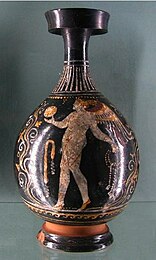A lekythos (Ancient Greek: λήκυθος; pl.: lekythoi) is a type of ancient Greek vessel used for storing oil, especially olive oil. It has a narrow body and one handle attached to the neck of the vessel, and is thus a narrow type of jug, with no pouring lip; the oinochoe is more like a modern jug. In the "shoulder" and "cylindrical" types which became the most common, especially the latter, the sides of the body are usually vertical by the shoulder, and there is then a sharp change of direction as the neck curves in; the base and lip are normally prominent and flared. However, there are a number of varieties, and the word seems to have been used even more widely in ancient times than by modern archeologists.[1] They are normally in pottery, but there are also carved stone examples.
Lekythoi were especially associated with funerary rites, and with the white ground technique of vase painting, which was too fragile for most items in regular use. Because of their handle they were normally only decorated with one image, on the other side from the handle;[2] they are often photographed with the handle hidden, to show the painted image.


